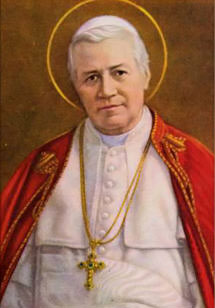A
atitude pessoal
Na festa de São Pio X, pedimos a
intercessão de tão insígne Pontífice para que imitemos o seu exemplo de caridade
e zelo.
Desde sua primeira encíclica, Pio X urgia por
caridade mesmo para com “aqueles que se nos opõe e persegue, vistos, talvez,
como piores do que realmente são”. Esta caridade não era um sinal de fraqueza,
mas estava fundamentada na esperança: “a esperança”, escreveu o Papa, “de que a
chama da caridade Cristã, paciente e afável, dissipará as trevas de suas almas e
trará a luz e a paz de Deus”.
Pio X também tinha sua esperança – de ver os
adversários da Igreja emendando seus caminhos e renunciando seus erros – no que
diz respeito aos modernistas.
Os testemunhos que citaremos o provarão de
maneira incontestável. Mas Pio X fez mais: discretamente deu assistência
financeira a alguns deles ou lhes arranjou outros ofícios; em outros casos,
mostrou-se prudente antes de condená-los. Era esta generosidade, nada
excepcional, incompatível com sua determinação na luta contra o modernismo? Como
pode o mesmo homem que impõe sanções, depõe clérigos, excomunga, simultaneamente
mostrar-se caridoso e contido? Durante o processo de beatificação, o Promotor da
Fé apresentou uma série de objeções; uma delas era: “Sejamos francos: a questão,
a única questão que, a meu ver, parece se levantar neste grande inquérito, é
saber se Pio X, em sua luta contra o modernismo, ultrapassou as fronteiras da
prudência e da justiça, particularmente em seus últimos anos…” [Novae Animadversiones, citado
em Conduite de s. Pie X, p. 14] A isso, o Postulador da Causa
respondeu com um volumoso dossiê de mais de 300 páginas no qual mostrava que Pio
X era “firme em seus princípios, correto em suas intenções e paciente e afável
com aqueles com quem lidava, mesmo se tivesse razões justas para expressar sua
angústia por causa deles”. [Ibid., p. 20]
Voltamo-nos a esta questão da atitude pessoal
de Pio X para com os modernistas e citaremos vários casos. Os contemporâneos de
Pio X talvez desconhecessem esses gestos de caridade e justiça da parte do
Pontífice. No dia seguinte à morte do Papa, Mons. Mignot, que era próximo dos
modernistas, repreendeu o falecido nos seguintes termos: “Pio X era um santo,
com um desinteresse raro para um italiano, mas suas idéias absolutas paralisavam
seu coração… Ele esmagou muitas almas, a quem um pouco de ternura teria mantido
no caminho correto”. [Carta de Mons. Mignot a
Hügel, 9 de setembro de 1914, citado por Poulat, Histoire, dogma et
critique, p. 480] Os historiadores do modernismo não mencionam os
gestos de caridade ou justiça de Pio X, ou o fazem apenas de passagem. O número
e a consistência destes atos mostram, todavia, que não foram resultados de
decisões excepcionais de sua parte, mas manifestavam uma disposição intelectual
e uma atitude espiritual. Na luta contra o fenômeno do modernismo,
todos os métodos eram usados, e sem piedade, pois Pio X considerava que a fé dos
fiéis estava em perigo e que o futuro da Igreja estava em jogo; por outro lado,
quando se tratava da sorte dos modernistas, Pio X, sabendo-o, fazia
grande esforço para ser o mais justo, prudente e caridoso possível.
Um exame das relações de Pio X com Loisy, o
mais famoso dos modernistas, dá-nos uma boa idéia de seus profundos sentimentos.
Como já vimos, quando Loisy manifestou sua disposição de se submeter, Pio X
exigia, insistia que o exegeta francês devesse fazer uma completa e sincera
submissão “com seu coração”. Loisy, que persistiu em seus erros após a
Pascendi, acabou excomungado. Viveu em retiro em Ceffonds, Haute-Marne,
e logo seria eleito para o Collège de France. No entanto, Pio X não o via como
um filho perdido da Igreja. Em 1908, recebendo o novo bispo de Châlons, Dom
Sevin, Pio X recomendou-lhe Loisy (a quem ele havia excomungado há pouco tempo).
As palavras do Papa foram relatadas pelo próprio Loisy: “O senhor será o bispo
do Pe. Loisy. Se tiver a oportunidade, trate-o com gentileza; e se ele der um
passo em sua direção, dê dois na direção dele”. [Loisy, Mémoires, vol. III, p. 27. Pe.
Lagrange dá outra versão destas palavras, versão que ouviu da boca de Dom Sevin;
quando o bispo de Châlons perguntara ao Papa que atitude deveria adotar com
relação a Loisy se este demonstrasse arrependimento, o Papa respondeu: Recebei-o
de braços abertos. Digo ao senhor que ele, meu filho, irá voltar” (Lagrange,
M. Loisy et le modernisme, p. 138)]
Outro caso é o do Pe. Murri. Como veremos, a
Liga Nacional Democrática que fundara foi condenada pelo Papa. Ele tinha
conhecidos laços com modernistas. Em abril de 1907, no despertar de uma série de
artigos nos quais Murri amargamente criticava a política do Vaticano na França,
Pio X enviou uma carta ao bispo da diocese deste líder democrático, instruindo-o
a informar a este último que estava suspenso a divinis. Quando, alguns
meses depois, a Encíclica Pascendi estava prestes a ser publicada,
havia uma certa expectativa de que Murri fosse imediatamente excomungado, dado
que estava absolutamente claro que o turbulento líder democrata cristão se
oporia à Encíclica. O problema foi colocado a Pio X, que preferiu ser paciente.
Em 25 de agosto de 1907, escreveu à Congregação do Santo Ofício: “Se tudo
estiver em ordem com o celebret do Pe. Romolo Murri, ele não pode, sem
grave injustiça, ser proibido de rezar Missa, na medida em que não realizou
qualquer ato condenado pela Encíclica”. [Citado por Dal-Gal, Pie X, p. 404]
Murri, contudo, persistiu publicamente em suas posições e foi, ao fim,
excomungado em 1909. Posteriormente, ele experimentou graves dificuldades
financeiras; Pio X soube disso e pagou-lhe uma pensão
mensal.[Depoimento do Cardeal Merry del Val, Summarium,
p. 195]
[…]
Pio X tinha de levar muitas coisas em
consideração: a salvaguarda da fé e do bem da Igreja, a necessidade e a
legitimidade de estudos em matérias de religião, o bem pessoal e a boa fé das
pessoas envolvidas, assim como as manobras, as ambições e o zelo das partes.
Enquanto Papa, seu dever eram aqueles primeiros; como cristão, estava obrigado a
seguir a caridade, prudência e justiça. [...] Pio X sentia como seu dever,
enquanto guardião da fé, combater o modernismo, e fazê-lo usando os mais
variados métodos e sem fraqueza, pois, como via, a própria existência da Igreja
estava ameaçada. Ao mesmo tempo, sem fazer qualquer concessão ao erro,
esforçava-se por ajudar os culpados ou suspeitos, e tomava grande cuidado em
limitar os excessos dos anti-modernistas. Uma de suas máximas favoritas era:
“devemos combater o erro sem ferir as pessoas envolvidas”.
Saint Pius X, Restorer of the Church –
Yves Chiron, Angelus Press, 2002, pp. 236-237;241-242. Tradução: Fratres in Unum.com.
Festividad de San Pio X, Papa y Confesor, y 102º Aniversario del Juramento Anti-modernista

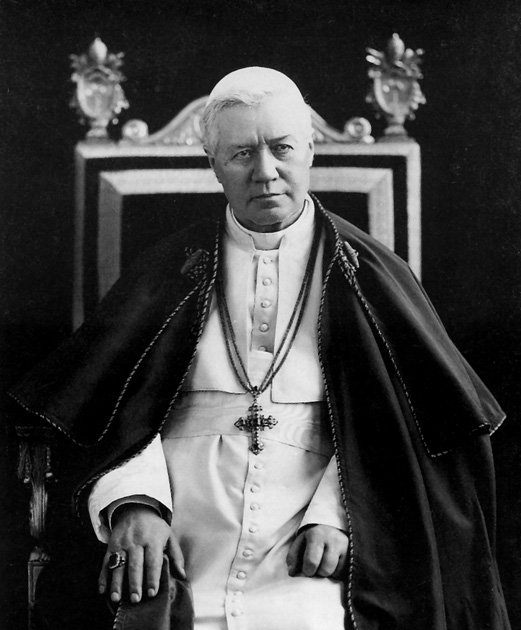
Hoy se celebra
la festividad de San Pío PP. X, dos días después del centésimo primer
aniversario de su Motu Proprio "Sacrorum Antistitum" contra el
Modernismo. En dicho motu proprio se imponía a todo el clero el
JURAMENTO CONTRA LOS ERRORES DEL MODERNISMO, que fue obligatorio desde
septiembre de 1910 hasta julio de 1967, pero cuyo contenido sigue siendo
Doctrina de la Iglesia.
Bajo estas
líneas pongo íntegro el texto del juramento en español:
FÓRMULA DEL JURAMENTO
Yo, _________ , abrazo y acepto firmemente
todas y cada una de las cosas que han sido definidas, afirmadas y declaradas por
el Magisterio inerrante de la Iglesia, principalmente aquellos puntos de
doctrina que directamente se oponen a los errores de la época presente.
Y en primer lugar: profeso que Dios, principio
y fin de todas las cosas, puede ser ciertamente conocido y, por tanto, también
demostrado, como la causa por sus efectos, por la luz natural de la razón
mediante las cosas que han sido hechas, es decir, por las obras visibles de la
creación.
En segundo lugar: admito y reconozco como
signos certísimos del origen divino de la religión cristiana los argumentos
externos de la revelación, esto es, hechos divinos, y en primer término, los
milagros y las profecías, y sostengo que son sobremanera acomodados a la
inteligencia de todas las épocas y de los hombres, aun los de este tiempo.
En tercer lugar: creo igualmente con fe firme
que la Iglesia, guardiana y maestra de la palabra revelada, fue próxima y
directamente instituida por el mismo verdadero e histórico Cristo, mientras
vivía entre nosotros, y que fue edificada sobre Pedro, príncipe de la jerarquía
apostólica, y sus sucesores para siempre.
Cuarto: acepto sinceramente la doctrina de la
fe transmitida hasta nosotros desde los Apóstoles por medio de los Padres
ortodoxos siempre en el mismo sentido y en la misma sentencia; y por tanto, de
todo punto rechazo la invención herética de la evolución de los dogmas, que
pasarían de un sentido a otro diverso del que primero mantuvo la Iglesia;
igualmente condeno todo error, por el que al depósito divino, entregado a la
Esposa de Cristo y que por ella ha de ser fielmente custodiado, sustituye un
invento filosófico o una creación de la conciencia humana, lentamente formada
por el esfuerzo de los hombres y que en adelante ha de perfeccionarse por
progreso indefinido.
Quinto: Sostengo con toda certeza y
sinceramente profeso que la fe no es un sentimiento ciego de la religión que
brota de los escondrijos de la subconsciencia, bajo presión del corazón y la
inclinación de la voluntad formada moralmente, sino un verdadero asentimiento
del entendimiento a la verdad recibida por fuera por oído, por el que creemos
ser verdaderas las cosas que han sido dichas, atestiguadas y reveladas por el
Dios personal, creador y Señor nuestro, y lo creemos por la autoridad de Dios,
sumamente veraz.
También me someto con la debida reverencia y de
todo corazón me adhiero alas condenaciones, declaraciones y prescripciones todas
que se contienen en la Carta Encíclica Pascendi y en el Decreto
Lamentabili, particularmente en lo relativo a la que llaman historia de los
dogmas.
Asimismo repruebo el error de los que afirman
que la fe propuesta por la Iglesia puede repugnar a la historia, y que los
dogmas católicos en el sentido en que ahora son entendidos, no pueden
conciliarse con los auténticos orígenes de la religión cristiana.
Condeno y rechazo también la sentencia de
aquellos que dicen que el cristiano erudito se reviste de doble personalidad,
una de creyente y otra de historiador, como si fuera lícito al historiador
sostenerlo que contradice a la fe del creyente, o sentar premisas de las que se
siga que los dogmas son falsos y dudosos, con tal de que éstos no se nieguen
directamente.
Repruebo igualmente el método de juzgar e
interpretar la Sagrada Escritura que, sin tener en cuenta la tradici6n de la
Iglesia, la analogía de la fe y las normas de la Sede Apostólica, sigue los
delirios de los racionalistas y abraza no menos libre que temerariamente la
crítica del texto como regla única y suprema.
Rechazo además la sentencia de aquellos que
sostienen que quien enseña la historia de la teología o escribe sobre esas
materias, tiene que dejar antes a un lado la opinión preconcebida, ora sobre el
origen sobrenatural de la tradición católica, ora sobre la promesa divina de una
ayuda para la conservación perenne de cada una de las verdades reveladas, y que
además los escritos de cada uno de los Padres han de interpretarse por los solos
principios de la ciencia, excluida toda autoridad sagrada, y con aquella
libertad de juicio con que suelen investigarse cualesquiera monumentos
profanos.
De manera general, finalmente, me profeso
totalmente ajeno al error por el que los modernistas sostienen que en la sagrada
tradición no hay nada divino, o lo que es mucho peor, lo admiten en sentido
panteístico, de suerte que ya no quede sino el hecho escueto y sencillo, que ha
de ponerse al nivel de los hechos comunes de la historia, a saber: unos hombres
que por su industria, ingenio y diligencia, continúan en las edades siguientes
la escuela comenzada por Cristo y sus Apóstoles.
Por tanto, mantengo firmísimamente la fe de los
Padres y la mantendré hasta el postrer aliento de mi vida sobre el carisma
cierto de la verdad, que está, estuvo y estará siempre en la sucesión del
episcopado desde los Apóstoles; no para que se mantenga lo que mejor y más apto
pueda parecer conforme a la cultura de cada época, sino para que nunca se crea
de otro modo, nunca de otro modo se entienda la verdad absoluta e inmutable
predicada desde el principio por los Apóstoles.
Todo esto prometo que lo he de guardar íntegra
y sinceramente y custodiar inviolablemente sin apartarme nunca de ello, ni
enseñando ni de otro modo cualquiera de palabra o por escrito.
Así lo prometo, así lo juro, así me ayude Dios
y estos Santos Evangelios de Dios.
HOJE
É A FESTA DE S. PI
St. Pius X – September 3
St. Pius X – September
3
Prof. Plinio Corrêa de
Oliveira
The life of
St. Pius X speaks to us in so many ways that it is difficult to choose the one
with a more formative character. But we can begin by stressing a curious facet
of his life that also signifies an aspect of the life of the
Church.
The times of
Pius IX and Leo XIII
We know that Pius IX, the predecessor of
St. Pius X, was a prototype of a counter-revolutionary Pope. He proclaimed the
dogmas of Papal Infallibility and the Immaculate Conception; he fought on every
front of combat and was attacked on all of them by the Revolution. His
pontificate closed at the apex of his confrontation with the Revolution, with
the troops of Garibaldi and Victor Emmanuel taking Rome as well as the
Pontifical Territories from the Pope.
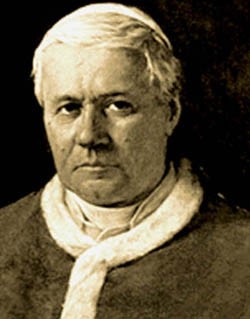
Giuseppe Melchiorre Sarto, St. Pius
X
After Pius IX, whose process of
canonization is ongoing, came Leo XIII. I have never heard anyone propose a
process of canonization for him. There is no record that even his greatest
enthusiasts ever considered this possibility. Recently (these comments were made in 1966), an ensemble of
letters by Leo XIII to his family was published by a German scholar, who, with
that delightful naiveté of many Germans, presented them exactly as they were
written. I believe that those letters destroyed any possibility of the
canonization of Leo XIII.
From a small perspective – because those
letters reflect only a very small part of his life – Leo XIII revealed in them
his great concern about the glory of the Pecci family, that is, his own family.
He had been Count Pecci. So, there are letters to his sister, his mother, and
other members of the family remarking how he did this and that as Pope, and that
his actions would bring great glory for the Pecci family. The lackluster name of
the Pecci family, he noted, would now be immortal! The publication of these
candid letters found an icy reception from the Italian press, and given its
inconvenience, the book was more or less set aside and forgotten.
To
show how such an attitude is unbefitting the role of a Pope, let me remind you
of an episode that took place in the Middle Ages. Pope Innocent III was
reigning. His pontificate was praiseworthy in many aspects. But he had the
weakness to construct a tower in honor of his family, the Conti family. He built
the Torre dei Conti over a site where Roman Emperors used to erect
historical monuments for their personal glory. Perhaps Innocent III was trying
to compare himself to them. The tower is still there, near the Coliseum.
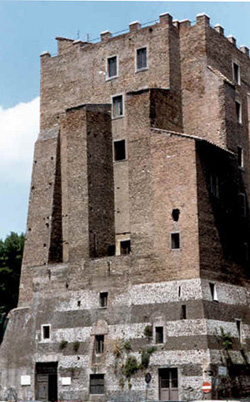
Innocent III commanded that the Tower of the Conti, above, be
built to glorify his own family
A holy
religious woman, whose name I don’t recall at this moment, had a vision that she
communicated to the Pope about this tower. In the revelation Our Lord ordered
her to tell Innocent III that because he made that tower to glorify his family,
he would remain in Purgatory until the last day of the world. Here is a
criterion to understand what Leo XIII’s vainglory regarding his family probably
represented in the eyes of God.
Leo XIII was a Pope whose pontificate
could be symbolized by the ralliement [in French, re-uniting], the policy
of uniting Catholic social-political views with the Masonic ideals of the French
Revolution, until then strongly condemned by the Church. That is, a policy
diametrically opposed to that of Pius IX.
St. Pius X was the
counter-revolutionary Pope who condemned the Sillon, condemned Modernism,
and re-established the Catholic position in France that had been shaken by the
ralliement. He was also the one who instituted the policy of permitting
First Communion for children at the age of reason, among many other splendid
things he did.
Leo XIII had a very long pontificate, so long that he saw
the deaths of all the Cardinals who had elected him. When the last of these
Cardinals died, he had a medal stamped saying to the body of Cardinals he had
created: “It was not you who chose me, but I who chose you.” It was another
manifestation of vainglory. It was this body of Cardinals created by Leo XIII
that, after he died, elected Pope St. Pius X.
A mysterious inner force that
restores the Church
The fact of his election illustrates
something of a mystery that exists in the life of the Church. Given her
intrinsic sanctity, everything follows in accord with the plans of God when the
hour of Divine Providence arrives. At the hour when God wants to intervene, even
in the darkest, more incomprehensible, and almost hopeless situation, a force
acts in the Church and it moves the action of men and the reaction of the
Catholic grassroots in the most unexpected and inconceivable ways.
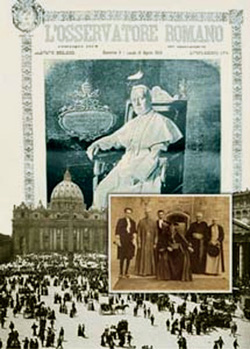
The surprise election of Giuseppe Sarto announced in the
Observatorre Romano the next
day
The election of St. Pius X was like
this, and it shows us that we should always consider the possibility that this
institutional force will intervene and do something that we could not imagine.
This force comes from the presence of Our Lord in the Church. More than in any
other domain of creation, in the Church a word from Him has a decisive weight
and can change everything. When things go awry in the Church, it is because God
chooses not to intervene. Our Lord sleeps in the bark of the Church, like He
slept in the boat with the Apostles. Our Lord was sleeping as the storm reached
its apex. The Apostles became fearful and awakened Him. Then He ordered the
storm to stop, and there was a great calm. How many times in the History of the
Church has Our Lord seemed to be sleeping! Perhaps if we would pray more for Him
to awaken, things would be different.
With the election of St. Pius X,
this happened. Cardinal Sarto made no effort to be elected. On the contrary, he
made a resistance to his own election, perhaps because he perceived the
overwhelming weight that he would have to carry on his shoulders. Finally he
accepted, but he lacked some of the many capacities necessary to exercise the
pontifical function. He was not an accomplished diplomat, for example, and was
unfamiliar with the great political questions of the time. He needed someone to
help him govern with regard to these important matters.
Then he became
acquainted with Cardinal Merry del Val. When St. Pius X accepted the Papacy, he
had no idea how he would be able to deal with those questions, but God put the
necessary man near him. This is just one highlight of his glorious pontificate.
Fulmination of
Modernism
When St. Pius X rose to the Pontifical Throne, a
large part of the good Catholic press was so discouraged and defeated that it
was near death. Almost all the elements of the Counter-Revolution were in an
analogous state. I read a report of a Catholic French ultramontane of that time
in which he described how his movement was so devastated that they did not even
realize during the first years of St. Pius X’s pontificate that he was their
champion. The nightmare they had endured under Leo XIII had lasted so long that
it took some time for them to awaken from that dark night, and begin to marvel
at the true dawn St. Pius X represented for the good cause.
It is good
for us to consider what his condemnation of Modernism represented. A conspiracy
had been established inside the Church, like a conspiracy inside a country, in
order to usurp the supreme power. It intended to submit the Church to a series
of reforms in order to adapt her to the errors of the Revolution. It wanted to
establish democracy throughout the Church; it wanted the Church to support and
collaborate with all the political leftist parties and movements; it prepared a
false ecumenism to be made with all false religions in order to spread religious
indifferentism everywhere so that no one would have certainty about the one true
Faith. For Modernism the faith inside of each person was sufficient. In brief,
it wanted the Catholic Church to stop being herself.
St. Pius X
discovered this conspiracy, and fulminated against it with his documents. This
is the first great characteristic of his pontificate, which would be enough to
immortalize him. Imagine if he had failed to do so. Today, any reaction against
Communism and Progressivism would be impossible. We are still in this fight
because he smashed Modernism at the beginning of the 20th century. We are here
now, because of the fierce energy of St. Pius X.
He inherited from his
predecessor a notable work, the restoration of Scholasticism. However, as soon
as Leo XIII died, Scholasticism began to be distorted in order to accommodate
Modernism. St. Pius X elaborated a summary of the fundamental thesis of Thomism
– a kind of appendix to the Encyclical Aeterni Patris – which he obliged
all teachers and professors of theology and philosophy to accept under oath.
With this he preserved the great edifice of Scholasticism from corruption.
Against the ideals of
the French Revolution
At that time, France was the most
influential nation in the world. The political and social life of France, the
pro and con positions of anti-clericalism, the confrontation between Revolution
and Counter-Revolution were followed and imitated by almost the whole world.
Years before, the Prince of Metternich, a famous Austrian minister, expressed
this well in a very picturesque way, saying, “When France has a cold, all Europe
sneezes.” This influence continued into the time of St. Pius X.
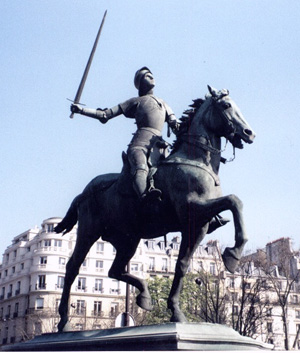
The beatification of St. Joan of Arc recalled the Catholic support
for the monarchy in France
In the
France of those days, there was a strong tendency, even among the Bishops, to
accept the separation between the Church and the State, along with other
principles of the French Revolution. St. Pius X prepared a bomb to destroy this
position. It was his Encyclical Vehementer Nos, in which he laid to rest
all the hopes of Laicism in France, the compromises being proposed by the French
government and the Liberal clergy, and initiated a true ideological war against
the revolutionary French regime. This bomb stopped or slowed down the march of
Revolution in its ensemble for a long time in France.
He gave another
important blow against the ideals of the French Revolution when he announced the
the beatification of St. Joan of Arc, an action that strongly displeased the
Revolution, because St. Joan of Arc represented Catholic France holding a sword
for the restoration of the legitimate monarchy. She also fought to maintain the
integrity of the French borders. The announcement of her beatification caused a
tremendous joy among the French people, and it considerably strengthened the
Catholic ultramontane cause.
The importance of early Communion for
children
Another great thing that St. Pius X did was to allow
Communion for children at age 7 and encourage daily Communion. I sustain that
this measure, besides having all the spiritual advantages we know, created an
enormous difficulty for the Devil and his cohorts to have power over many souls.
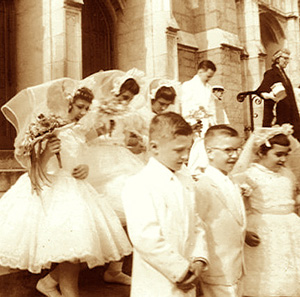
Permitting early First Communion for children struck a strong blow
to the Revolution
Let me explain this
point. Before this measure of St. Pius X, Catholics would make their First
Communion only in their late childhood or adolescence, after many mortal sins
would have already been committed, giving the Devil a special power over them.
For this reason, many souls abandoned the Catholic Faith even before they
received First Communion, making them an easy prey for the Devil and Secret
Societies.
On the contrary, in a child who receives his First Communion
in the state of his first innocence and has the possibility of making frequent
Communions, Our Lord establishes Himself with a special power over the soul and,
consequently, diminishes the power of the Devil. This also diminishes the power
of Masonry and other Secret Societies over those Catholics who become members of
such organizations. Their power over those members will never be as great as it
would have been had they not received First Communion as children.
I
consider this measure of St. Pius X as a fundamental cause for the loss of
influence and dominion of Masonry over its members. I am not talking about its
control over world events, where Masonry became more powerful, but rather its
control over the interior of souls, where it became weaker.
A Prophet who was rejected
St. Pius X was
not only a good Pope; he was a saint and a counter-revolutionary. In a certain
way he was also a prophet. He made a last appeal for the people of his era to
persevere and prevent the chastisements that could come. If the world would not
listen to his appeal, then World War I would come as a chastisement. Cardinal
Merry del Val reported in his memoirs that St. Pius X predicted the war as the
end of an era. One can see that there is a link between St. Pius X and Fátima.
Since his pontificate was not well accepted, the war came, and this was a
principle cause for the rise of Communism in Russia, and afterward, the
dissemination of its errors all over the world. One thing is linked to the
other.
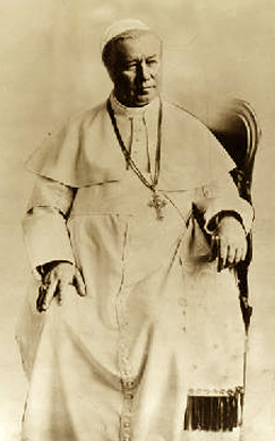
Pope St. Pius X
The
magazine La Critique du Liberalisme [The Critique of Liberalism]
published an article about the death of St Pius X. The author sustains the
thesis that St. Pius X was murdered on the order of Masonry. He affirms that St.
Pius X caught a simple cold, but suddenly and inexplicably that cold would cause
his death. One morning when he awakened, he could no longer speak, which was not
proportional to that cold; he tried to write in order to communicate something,
but also found himself unable to write. Soon afterward he died.
The
author also tells about a young, brilliant naval officer in Prussia who became a
Jesuit. After being ordained, he became a nurse and was named to take care of
the Pope during that cold. On that final night of the life of St. Pius X, he was
closely attending the Pope. After the Pope died, the Jesuit returned to Prussia,
left the Order, and returned to a brilliant career as a naval officer. During
the war he became a submarine commander. The author affirms that St. Pius X was
killed on the order of the German Masonry, and therefore, would be a martyr. I
repeat the thesis of this article without having formed my own opinion on
it.
In his memoirs Cardinal Merry del Val confirms that St. Pius X could
not speak or write, and he adds: “No one will ever know what happened that
night.” It is a mysterious phrase.
In 1950, I followed the funeral
ceremonies for Marc Sangnier in the French press. Sangnier had been the leader
of the Sillon movement, which was condemned by St. Pius X in the
Encyclical Notre charge apostolique. The burial of Sangnier was a
veritable apotheosis. His body was exposed for public viewing in the Cathedral
of Notre Dame, the burial cortege was followed by members of the French
government, Senate, House of Representatives, diplomatic body, and numerous
ecclesiastics. All this was done in a spirit of protest against the condemnation
St. Pius X made of Modernism.
One year later, St. Pius X was beatified.
There were no celebrations in France, at least nothing that came close to those
for Sangnier. This shows how St. Pius X was rejected.
Even with this
hatred, Divine Providence made the memory of St. Pius X shine above the
firmament of the Church to illuminate the dark days that would come after him.
He is an astral body, like a moon, that prolongs the glimmer of the Papacy amid
the darkness that fell over the Church after his death.
What should we
ask of St. Pius X? There are so many things to ask that the best advice is to
ask for everything: the unexpected victories, perseverance, the gift of raising
the fury of the enemies, astuteness, and the courage to walk even to a martyr’s
death if necessary.



Prof. Plinio Corrêa de Oliveira
source
The Saint of the Day features highlights
from the lives of saints based on comments made by the late Prof. Plinio Corrêa
de Oliveira. Following the example of St. John Bosco who used to make similar
talks for the boys of his College, each evening it was Prof. Plinio’s custom to
make a short commentary on the lives of the next day’s saint in a meeting for
youth in order to encourage them in the practice of virtue and love for the
Catholic Church.
Prof. Plinio Corrêa de Oliveira
| The life of
St. Pius X speaks to us in so many ways that it is difficult to choose the one
with a more formative character. But we can begin by stressing a curious facet
of his life that also signifies an aspect of the life of the
Church. The times of Pius IX and Leo XIII We know that Pius IX, the predecessor of St. Pius X, was a prototype of a counter-revolutionary Pope. He proclaimed the dogmas of Papal Infallibility and the Immaculate Conception; he fought on every front of combat and was attacked on all of them by the Revolution. His pontificate closed at the apex of his confrontation with the Revolution, with the troops of Garibaldi and Victor Emmanuel taking Rome as well as the Pontifical Territories from the Pope.
From a small perspective – because those letters reflect only a very small part of his life – Leo XIII revealed in them his great concern about the glory of the Pecci family, that is, his own family. He had been Count Pecci. So, there are letters to his sister, his mother, and other members of the family remarking how he did this and that as Pope, and that his actions would bring great glory for the Pecci family. The lackluster name of the Pecci family, he noted, would now be immortal! The publication of these candid letters found an icy reception from the Italian press, and given its inconvenience, the book was more or less set aside and forgotten. To show how such an attitude is unbefitting the role of a Pope, let me remind you of an episode that took place in the Middle Ages. Pope Innocent III was reigning. His pontificate was praiseworthy in many aspects. But he had the weakness to construct a tower in honor of his family, the Conti family. He built the Torre dei Conti over a site where Roman Emperors used to erect historical monuments for their personal glory. Perhaps Innocent III was trying to compare himself to them. The tower is still there, near the Coliseum.
Leo XIII was a Pope whose pontificate could be symbolized by the ralliement [in French, re-uniting], the policy of uniting Catholic social-political views with the Masonic ideals of the French Revolution, until then strongly condemned by the Church. That is, a policy diametrically opposed to that of Pius IX. St. Pius X was the counter-revolutionary Pope who condemned the Sillon, condemned Modernism, and re-established the Catholic position in France that had been shaken by the ralliement. He was also the one who instituted the policy of permitting First Communion for children at the age of reason, among many other splendid things he did. Leo XIII had a very long pontificate, so long that he saw the deaths of all the Cardinals who had elected him. When the last of these Cardinals died, he had a medal stamped saying to the body of Cardinals he had created: “It was not you who chose me, but I who chose you.” It was another manifestation of vainglory. It was this body of Cardinals created by Leo XIII that, after he died, elected Pope St. Pius X. A mysterious inner force that restores the Church The fact of his election illustrates something of a mystery that exists in the life of the Church. Given her intrinsic sanctity, everything follows in accord with the plans of God when the hour of Divine Providence arrives. At the hour when God wants to intervene, even in the darkest, more incomprehensible, and almost hopeless situation, a force acts in the Church and it moves the action of men and the reaction of the Catholic grassroots in the most unexpected and inconceivable ways.
With the election of St. Pius X, this happened. Cardinal Sarto made no effort to be elected. On the contrary, he made a resistance to his own election, perhaps because he perceived the overwhelming weight that he would have to carry on his shoulders. Finally he accepted, but he lacked some of the many capacities necessary to exercise the pontifical function. He was not an accomplished diplomat, for example, and was unfamiliar with the great political questions of the time. He needed someone to help him govern with regard to these important matters. Then he became acquainted with Cardinal Merry del Val. When St. Pius X accepted the Papacy, he had no idea how he would be able to deal with those questions, but God put the necessary man near him. This is just one highlight of his glorious pontificate. Fulmination of Modernism When St. Pius X rose to the Pontifical Throne, a large part of the good Catholic press was so discouraged and defeated that it was near death. Almost all the elements of the Counter-Revolution were in an analogous state. I read a report of a Catholic French ultramontane of that time in which he described how his movement was so devastated that they did not even realize during the first years of St. Pius X’s pontificate that he was their champion. The nightmare they had endured under Leo XIII had lasted so long that it took some time for them to awaken from that dark night, and begin to marvel at the true dawn St. Pius X represented for the good cause. It is good for us to consider what his condemnation of Modernism represented. A conspiracy had been established inside the Church, like a conspiracy inside a country, in order to usurp the supreme power. It intended to submit the Church to a series of reforms in order to adapt her to the errors of the Revolution. It wanted to establish democracy throughout the Church; it wanted the Church to support and collaborate with all the political leftist parties and movements; it prepared a false ecumenism to be made with all false religions in order to spread religious indifferentism everywhere so that no one would have certainty about the one true Faith. For Modernism the faith inside of each person was sufficient. In brief, it wanted the Catholic Church to stop being herself. St. Pius X discovered this conspiracy, and fulminated against it with his documents. This is the first great characteristic of his pontificate, which would be enough to immortalize him. Imagine if he had failed to do so. Today, any reaction against Communism and Progressivism would be impossible. We are still in this fight because he smashed Modernism at the beginning of the 20th century. We are here now, because of the fierce energy of St. Pius X. He inherited from his predecessor a notable work, the restoration of Scholasticism. However, as soon as Leo XIII died, Scholasticism began to be distorted in order to accommodate Modernism. St. Pius X elaborated a summary of the fundamental thesis of Thomism – a kind of appendix to the Encyclical Aeterni Patris – which he obliged all teachers and professors of theology and philosophy to accept under oath. With this he preserved the great edifice of Scholasticism from corruption. Against the ideals of the French Revolution At that time, France was the most influential nation in the world. The political and social life of France, the pro and con positions of anti-clericalism, the confrontation between Revolution and Counter-Revolution were followed and imitated by almost the whole world. Years before, the Prince of Metternich, a famous Austrian minister, expressed this well in a very picturesque way, saying, “When France has a cold, all Europe sneezes.” This influence continued into the time of St. Pius X.
He gave another important blow against the ideals of the French Revolution when he announced the the beatification of St. Joan of Arc, an action that strongly displeased the Revolution, because St. Joan of Arc represented Catholic France holding a sword for the restoration of the legitimate monarchy. She also fought to maintain the integrity of the French borders. The announcement of her beatification caused a tremendous joy among the French people, and it considerably strengthened the Catholic ultramontane cause. The importance of early Communion for children Another great thing that St. Pius X did was to allow Communion for children at age 7 and encourage daily Communion. I sustain that this measure, besides having all the spiritual advantages we know, created an enormous difficulty for the Devil and his cohorts to have power over many souls.
On the contrary, in a child who receives his First Communion in the state of his first innocence and has the possibility of making frequent Communions, Our Lord establishes Himself with a special power over the soul and, consequently, diminishes the power of the Devil. This also diminishes the power of Masonry and other Secret Societies over those Catholics who become members of such organizations. Their power over those members will never be as great as it would have been had they not received First Communion as children. I consider this measure of St. Pius X as a fundamental cause for the loss of influence and dominion of Masonry over its members. I am not talking about its control over world events, where Masonry became more powerful, but rather its control over the interior of souls, where it became weaker. A Prophet who was rejected St. Pius X was not only a good Pope; he was a saint and a counter-revolutionary. In a certain way he was also a prophet. He made a last appeal for the people of his era to persevere and prevent the chastisements that could come. If the world would not listen to his appeal, then World War I would come as a chastisement. Cardinal Merry del Val reported in his memoirs that St. Pius X predicted the war as the end of an era. One can see that there is a link between St. Pius X and Fátima. Since his pontificate was not well accepted, the war came, and this was a principle cause for the rise of Communism in Russia, and afterward, the dissemination of its errors all over the world. One thing is linked to the other.
The author also tells about a young, brilliant naval officer in Prussia who became a Jesuit. After being ordained, he became a nurse and was named to take care of the Pope during that cold. On that final night of the life of St. Pius X, he was closely attending the Pope. After the Pope died, the Jesuit returned to Prussia, left the Order, and returned to a brilliant career as a naval officer. During the war he became a submarine commander. The author affirms that St. Pius X was killed on the order of the German Masonry, and therefore, would be a martyr. I repeat the thesis of this article without having formed my own opinion on it. In his memoirs Cardinal Merry del Val confirms that St. Pius X could not speak or write, and he adds: “No one will ever know what happened that night.” It is a mysterious phrase. In 1950, I followed the funeral ceremonies for Marc Sangnier in the French press. Sangnier had been the leader of the Sillon movement, which was condemned by St. Pius X in the Encyclical Notre charge apostolique. The burial of Sangnier was a veritable apotheosis. His body was exposed for public viewing in the Cathedral of Notre Dame, the burial cortege was followed by members of the French government, Senate, House of Representatives, diplomatic body, and numerous ecclesiastics. All this was done in a spirit of protest against the condemnation St. Pius X made of Modernism. One year later, St. Pius X was beatified. There were no celebrations in France, at least nothing that came close to those for Sangnier. This shows how St. Pius X was rejected. Even with this hatred, Divine Providence made the memory of St. Pius X shine above the firmament of the Church to illuminate the dark days that would come after him. He is an astral body, like a moon, that prolongs the glimmer of the Papacy amid the darkness that fell over the Church after his death. What should we ask of St. Pius X? There are so many things to ask that the best advice is to ask for everything: the unexpected victories, perseverance, the gift of raising the fury of the enemies, astuteness, and the courage to walk even to a martyr’s death if necessary.
|
S. Pio X nutrì il gregge con la vera dottrina
San Pio X nutrì il gregge con la vera dottrina
 Oggi
ricorre la festa di San Pio X e mi piace ricordarlo, come ha fatto Rorate
Caeli, con la citazione dell'Allocuzione Si Diligis rivolta da
Pio XII a Cardinali, Arcivescovi e Vescovi dopo la canonizzazione del grande
Pontefice, il 31 Maggio 1954. Ho messo il link all'unico testo (in latino)
presente sul sito della Santa Sede.
Oggi
ricorre la festa di San Pio X e mi piace ricordarlo, come ha fatto Rorate
Caeli, con la citazione dell'Allocuzione Si Diligis rivolta da
Pio XII a Cardinali, Arcivescovi e Vescovi dopo la canonizzazione del grande
Pontefice, il 31 Maggio 1954. Ho messo il link all'unico testo (in latino)
presente sul sito della Santa Sede.
E così mi sono accorta di quanto la
traduzione inglese impoverisca il contenuto mirabile del testo e di quanta
importanza esso abbia nei copiosi riferimenti al Magistero ed al munus
docendi.
Nella ricorrenza odierna riporto, come memoriale, il
significativo incipit e mi riprometto, con calma, di continuare a
tradurre direttamente dal testo latino anche le altre parti che hanno costituito
per me una sorpresa e ci saranno di grande utilità. A meno che qualche lettore
non possa ricavare dalle raccolte il testo italiano e gentilmente me lo invii;
gliene sarei molto grata.
« Se ami... pasci ». Quale sia il significato
del lavoro apostolico, la sua virtù esaltata, la fonte e l'origine dei suoi
meriti lo insegna il comando del nostro divin Salvatore all'apostolo Pietro, col
quale ha inizio la Messa in onore di uno o più Sommi
Pontefici.
Gesù Cristo, sommo ed eterno Sacerdote e
Pastore delle anime, per noi ha insegnato cose grandi, ha fatto cose mirabili,
ha sopportato cose molto dure. Pio X, il vescovo di Roma, che è stata nostra
grande gioia iscrivere nella lista dei santi, seguendo da vicino le orme del suo
Divino Maestro, ha preso il comando dalle labbra di Cristo e strenuamente, lo ha
svolto: pascendo amò e amando nutrì. Amava Cristo e nutrì il suo gregge : dai
tesori celesti che il misericordioso Redentore ha portato sulla terra, bevve con
parsimonia quel che ha distribuito largamente al gregge : il nutrimento della
verità, i misteri celesti, la suprema grazia del sacrificio e sacramento
eucaristico, la dolcezza della carità, la serietà nel governo, la fortezza in
difesa; ha dato tutto se stesso e quelle cose che l'Autore e Datore di ogni bene
aveva elargito su di lui. [...]
 Oggi
ricorre la festa di San Pio X e mi piace ricordarlo, come ha fatto Rorate
Caeli, con la citazione dell'Allocuzione Si Diligis rivolta da
Pio XII a Cardinali, Arcivescovi e Vescovi dopo la canonizzazione del grande
Pontefice, il 31 Maggio 1954. Ho messo il link all'unico testo (in latino)
presente sul sito della Santa Sede.
Oggi
ricorre la festa di San Pio X e mi piace ricordarlo, come ha fatto Rorate
Caeli, con la citazione dell'Allocuzione Si Diligis rivolta da
Pio XII a Cardinali, Arcivescovi e Vescovi dopo la canonizzazione del grande
Pontefice, il 31 Maggio 1954. Ho messo il link all'unico testo (in latino)
presente sul sito della Santa Sede.E così mi sono accorta di quanto la traduzione inglese impoverisca il contenuto mirabile del testo e di quanta importanza esso abbia nei copiosi riferimenti al Magistero ed al munus docendi.
Nella ricorrenza odierna riporto, come memoriale, il significativo incipit e mi riprometto, con calma, di continuare a tradurre direttamente dal testo latino anche le altre parti che hanno costituito per me una sorpresa e ci saranno di grande utilità. A meno che qualche lettore non possa ricavare dalle raccolte il testo italiano e gentilmente me lo invii; gliene sarei molto grata.
« Se ami... pasci ». Quale sia il significato del lavoro apostolico, la sua virtù esaltata, la fonte e l'origine dei suoi meriti lo insegna il comando del nostro divin Salvatore all'apostolo Pietro, col quale ha inizio la Messa in onore di uno o più Sommi Pontefici.
Gesù Cristo, sommo ed eterno Sacerdote e Pastore delle anime, per noi ha insegnato cose grandi, ha fatto cose mirabili, ha sopportato cose molto dure. Pio X, il vescovo di Roma, che è stata nostra grande gioia iscrivere nella lista dei santi, seguendo da vicino le orme del suo Divino Maestro, ha preso il comando dalle labbra di Cristo e strenuamente, lo ha svolto: pascendo amò e amando nutrì. Amava Cristo e nutrì il suo gregge : dai tesori celesti che il misericordioso Redentore ha portato sulla terra, bevve con parsimonia quel che ha distribuito largamente al gregge : il nutrimento della verità, i misteri celesti, la suprema grazia del sacrificio e sacramento eucaristico, la dolcezza della carità, la serietà nel governo, la fortezza in difesa; ha dato tutto se stesso e quelle cose che l'Autore e Datore di ogni bene aveva elargito su di lui. [...]
ST. PIUS X AND THE PRIEST
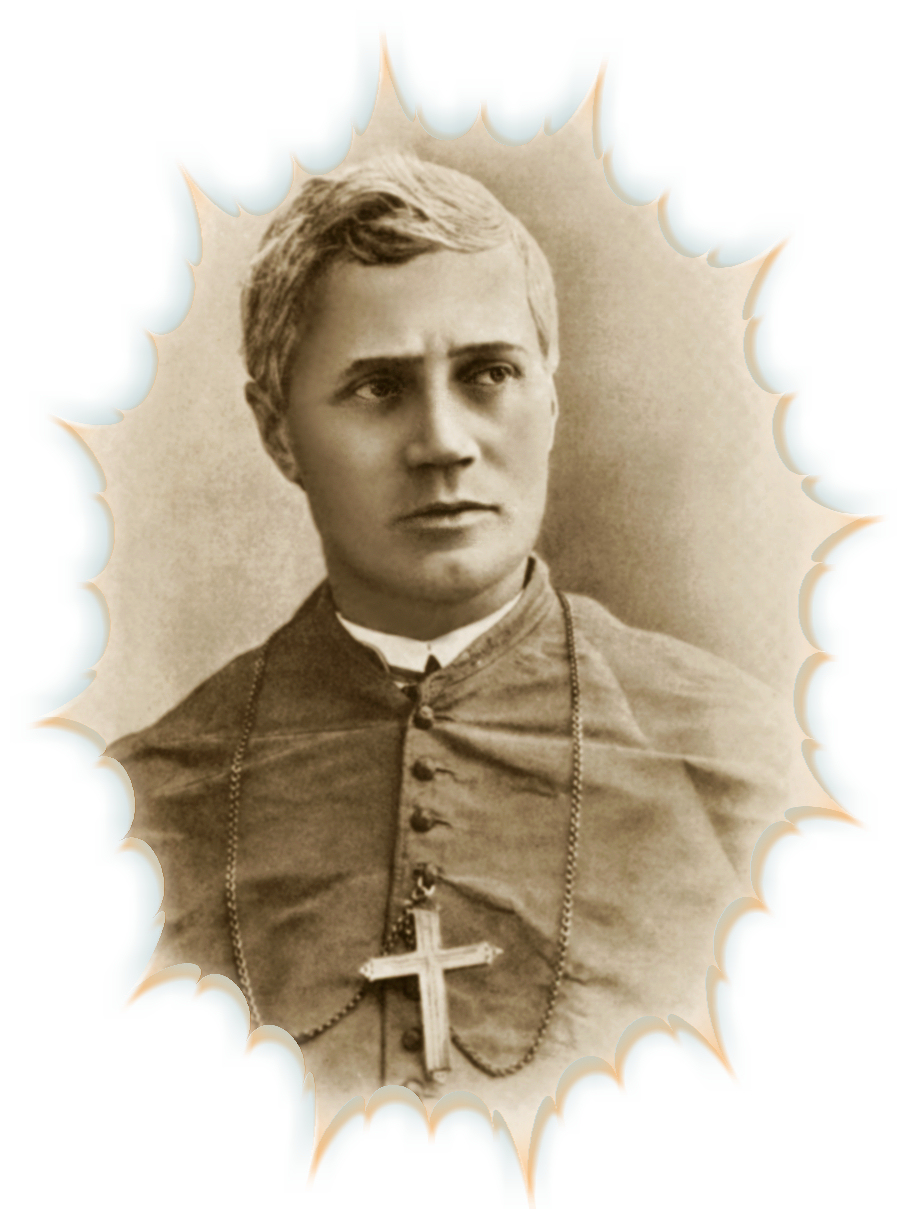

The
Priesthood 2-1
 RECIPE FOR HOLINESS
RECIPE FOR HOLINESS
ST. PIUS X AND THE
PRIEST Nihil Obstat: Joannes McCormack, Cens. Dep. die 2 Maii
1959
Imprimatur: + Joannes Kyne Epus. Miden. die 2 Maii 1959
CONTENTS: PREFACE
INTRODUCTION
HOLINESS
OF LIFE
MEANS TO
HOLINESS
PIETY
AND PRAYER
SACRIFICE
CHARITY
ZEAL
DIGNITY
AND PROPRIETY
PREACHING
SOCIAL
APOSTOLATE


The Priesthood 2-1
 RECIPE FOR HOLINESS
RECIPE FOR HOLINESS ST. PIUS X AND THE PRIEST Nihil Obstat: Joannes McCormack, Cens. Dep. die 2 Maii 1959
Imprimatur: + Joannes Kyne Epus. Miden. die 2 Maii 1959
CONTENTS: PREFACE
INTRODUCTION
HOLINESS OF LIFE
MEANS TO HOLINESS
PIETY AND PRAYER
SACRIFICE
CHARITY
ZEAL
DIGNITY AND PROPRIETY
PREACHING
SOCIAL APOSTOLATE

 inundado por um mistério de luz que é Deus e N´Ele vi e ouvi -A ponta da lança como chama que se desprende, toca o eixo da terra, – Ela estremece: montanhas, cidades, vilas e aldeias com os seus moradores são sepultados. - O mar, os rios e as nuvens saem dos seus limites, transbordam, inundam e arrastam consigo num redemoinho, moradias e gente em número que não se pode contar , é a purificação do mundo pelo pecado em que se mergulha. - O ódio, a ambição provocam a guerra destruidora! - Depois senti no palpitar acelerado do coração e no meu espírito o eco duma voz suave que dizia: – No tempo, uma só Fé, um só Batismo, uma só Igreja, Santa, Católica, Apostólica: - Na eternidade, o Céu!
inundado por um mistério de luz que é Deus e N´Ele vi e ouvi -A ponta da lança como chama que se desprende, toca o eixo da terra, – Ela estremece: montanhas, cidades, vilas e aldeias com os seus moradores são sepultados. - O mar, os rios e as nuvens saem dos seus limites, transbordam, inundam e arrastam consigo num redemoinho, moradias e gente em número que não se pode contar , é a purificação do mundo pelo pecado em que se mergulha. - O ódio, a ambição provocam a guerra destruidora! - Depois senti no palpitar acelerado do coração e no meu espírito o eco duma voz suave que dizia: – No tempo, uma só Fé, um só Batismo, uma só Igreja, Santa, Católica, Apostólica: - Na eternidade, o Céu! 
